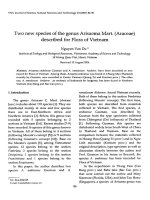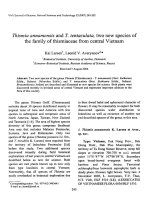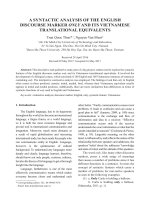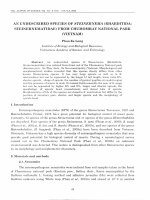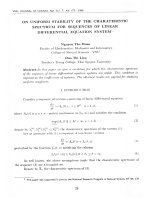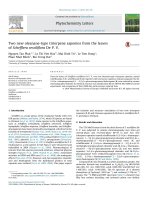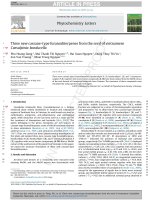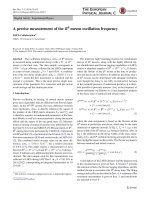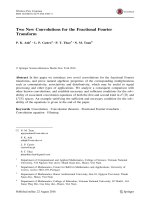DSpace at VNU: Three new species of the water strider genus Rhyacobates Esaki, 1923 (Hemiptera: Gerridae) from Vietnam
Bạn đang xem bản rút gọn của tài liệu. Xem và tải ngay bản đầy đủ của tài liệu tại đây (5.47 MB, 16 trang )
Zootaxa 4121 (5): 501–516
/>Copyright © 2016 Magnolia Press
Article
ISSN 1175-5326 (print edition)
ZOOTAXA
ISSN 1175-5334 (online edition)
/> />
Three new species of the water strider genus Rhyacobates Esaki, 1923
(Hemiptera: Gerridae) from Vietnam
A.D. TRAN & X.Q. NGUYEN
Tran Anh Duc & Nguyen Xuan Quynh, Department of Invertebrate Zoology, Faculty of Biology, Hanoi University of Science (Vietnam
National University, Hanoi), 334 Nguyen Trai, Thanh Xuan, Hanoi, Vietnam. E-mail:
Abstract
Three new species: Rhyacobates zetteli sp.n., R. angustus sp.n., and R. constrictus sp.n., all from mountainous areas of
northern Vietnam, are described. With these new taxa, a total of six species of Rhyacobates has been recorded from
Vietnam. A key to species of Rhyacobates occurring in Vietnam is provided.
Key words: Gerridae, Rhyacobates, new species, Vietnam
Introduction
The genus Rhyacobates Esaki, 1923 has its distribution in China, Korea, Taiwan, northern Thailand, northern
Myanmar, and northern Vietnam (Andersen & Chen 1995; Tran & Yang 2006). Species of Rhyacobates are strong
skaters, occupying fast flowing parts of rivers and streams. Although the distribution range of the genus is
relatively wide, most species are only known from their type localities, except R. takahashii Esaki, 1923 and R.
abdominalis Andersen & Chen, 1995. Rhyacobates takahashii is endemic to Taiwan but widespread within the
island (Andersen & Chen 1995). Rhyacobates abdominalis is found in two disjunct general localities: eastern
China (Guangdong Prov.) and northwestern Vietnam (Lao Cai Prov.) (Andersen & Chen 1995; Tran & Yang 2006).
Only R. malaisei Andersen & Chen, 1995 is found in three countries: China (Yunnan Prov.), Myanmar, and
Thailand (Chiang Mai Prov.) (see Andersen & Chen 1995), but these areas are geographically close to each other.
This fact suggests that our knowledge on the distribution of species of Rhyacobates is still poor and there have not
been adequate sampling efforts. Andersen & Chen (1995), in their revision of this genus, recognised nine species,
excluding Rhyacobates imadatei Miyamoto, 1967. Andersen & Chen (1995) believed that this species did not
belong to Rhyacobates due to various morphological inconsistencies with their generic definition. Subsequent
studies by Polhemus & Zettel (1997), Zettel & Thirumalai (2001a, b), and Chen et al. (2005) also acknowledged
the incorrect placement of this species in Rhyacobates, but no taxonomic decision was made. Eventually, Zettel
(2009) placed Rhyacobates imadatei Miyamoto in a genus of its own, Celerobates Zettel, 2009.
Tran & Yang (2006) provided the first records of Rhyacobates from Vietnam, including descriptions of two
new species, R. anderseni Tran & Yang, and R. gongvo Tran & Yang. The present paper reports three more species
from Vietnam, all new to science and they are described herein. Thus, to date, the total number of described species
of the genus has been raised to 14.
Material and methods
Materials used in this study have been deposited in the following museums or collections:
NHMW
ZMHU
Natural History Museum, Vienna (Austria)
Zoological Collection of the Biological Museum, Hanoi University of Science (Vietnam)
Accepted by R. Sites: 10 May 2016; published: 13 Jun. 2016
501
ZRC
Zoological Reference Collection, Lee Kong Chian Natural History Museum, National University of
Singapore (Singapore)
Material was studied with binocular microscopes. Measurements were mainly made with a stage micrometre
attached to oculars of the microscopes. Lengths of body segments (thoracic or abdominal) are measured along the
midline. All measurements are given in millimetres. Line drawings were made with the help of a camera lucida
fixed to the microscopes. Some habitus illustrations were taken with a digital SLR camera using macro lenses.
Taxonomy
Rhyacobates Esaki, 1923
Rhyacobates Esaki, 1923: 387 (type species: Rhyacobates takahashii Esaki, 1923); Hungerford & Matsuda, 1960: 8 (key to
genus); Matsuda, 1960: 273–276.
Esakobates Lundblad, 1934: 22 (type species: Esakobates svenhedini Lundblad, 1934); (synonymized by Hungerford &
Matsuda, 1959: 69).
Key to species of Rhyacobates occurring in Vietnam
1.
2.
3.
4.
-
5.
-
Both sexes: mesonotum totally black, without yellow marking. Female: abdominal sternum 7 without connexival process,
connexival and posterolateral margins expanded, folded inwards and covering dorsum of genitalia (Figs. 34–39). . . . . . . . . . .
. . . . . . . . . . . . . . . . . . . . . . . . . . . . . . . . . . . . . . . . . . . . . . . . . . . . . . . . . . . . . . . . . . . . . . . . . . . . . . . . . . . . . R. constrictus sp.n.
Both sexes: mesonotum with median yellow marking. Female: abdominal sternum 7 with connexival process, connexival and
posterolateral margins not modified as above. . . . . . . . . . . . . . . . . . . . . . . . . . . . . . . . . . . . . . . . . . . . . . . . . . . . . . . . . . . . . . . 2
Male: mesonotum with slender yellow median stripe only on posterior half. Female: posterior margin of metanotum with a
conspicuous median process; abdomen short, ventral length of abdomen about 0.2 times body length.. . . . . . . . . R. anderseni
Male: mesonotum with yellow median marking distinctly longer than half the length of mesonotum. Female: metanotum
without median process; abdomen longer, ventral length of abdomen about 0.4–0.5 times body length . . . . . . . . . . . . . . . . . . 3
Body length of male at least 7.3 mm, of female at least 9.8 mm. Female: tergum 7 with median process on posterior margin. 4
Body length of male at most 7.0 mm, of female at most 10.0 mm. Female: tergum 7 with posterior margin straight, without
median process. . . . . . . . . . . . . . . . . . . . . . . . . . . . . . . . . . . . . . . . . . . . . . . . . . . . . . . . . . . . . . . . . . . . . . . . . . . . . . . . . . . . . . . 5
Male: pronotum chiefly yellow; mesonotum with broad, sub-oval yellow median marking; metanotum with broad crownshaped yellow marking (Fig. 12). Female: sternum 7 with short connexival processes; posterior margin of sternum 7 bilobate
(Figs. 21, 22) . . . . . . . . . . . . . . . . . . . . . . . . . . . . . . . . . . . . . . . . . . . . . . . . . . . . . . . . . . . . . . . . . . . . . . . . . . . . . . R. zetteli sp.n.
Male: both pronotum and mesonotum with slender yellow median marking; metanotum without yellow marking. Female:
sternum 7 with longer and sub-triangular connexival processes (Figs. 8, 10); posterior margin of sternum 7 without lobe,
broadly convex (Fig. 9). . . . . . . . . . . . . . . . . . . . . . . . . . . . . . . . . . . . . . . . . . . . . . . . . . . . . . . . . . . . . . . . . . . . R. angustus sp.n.
Male: yellow stripe on mesonotum about three quarters of mesonotum length, not reaching anterior margin; paramere without
hook-shaped apex. Female: abdomen straight, abdominal segment 7 with two long dorsal processes, posterior ventral margin
straight and without median projection. . . . . . . . . . . . . . . . . . . . . . . . . . . . . . . . . . . . . . . . . . . . . . . . . . . . . . . . . . . . . R. gongvo
Male: yellow stripe on mesonotum almost as long as mesonotum length; paramere with hook-shaped apex. Female: distal half
of abdomen curved upwards; abdominal segment 7 without long dorsal process, posterior ventral margin with small and
pointed median projection. . . . . . . . . . . . . . . . . . . . . . . . . . . . . . . . . . . . . . . . . . . . . . . . . . . . . . . . . . . . . . . . . . . . R. abdominalis
Rhyacobates angustus sp.n.
(Figs. 1–10)
Material examined. Holotype (apterous female) and allotype (apterous male),VIETNAM, Lao Cai Prov., Sa Pa,
Ban Ho, Ban Den, Nam Pu stream (feeder stream of Muong Hoa stream), 22°15.709’N 103°58.054’E, 416 m asl.,
coll. Tran A.D. et al., 29 May 2013, TAD1316 (ZMHU).
Paratypes: 2 males (apterous), same locality data as holotype (ZMHU).
Description. Size: apterous morph, males, length 7.7–8.1 (allotype 8.0), width 2.26–2.40 (allotype 2.40);
female (holotype), length 11.3, width 2.95.
Colour: Dorsum of body mainly black, covered with silvery pubescence, especially on thoracic pleura,
metacoxa and abdomen. Dorsum of head yellow with median, longitudinal brown mark on anterior three quarters.
502 · Zootaxa 4121 (5) © 2016 Magnolia Press
TRAN & NGUYEN
Antennae mainly black, segment 4 with whitish area in distal two-fifths. Pronotum mainly black with median
yellow mark (in female, width of mark broad, about one third of pronotum mark; in male, yellow mark narrow).
Mesonotum black with median yellow mark from anterior fifth to posterior margin; median mark of female broader
than in male. Metanotum black, in female with median yellow marking, in male without yellow mark. Abdominal
terga of male chiefly black or brown. Abdominal terga of female mainly black or brown, with yellow connexiva.
Venter of body covered with silvery and golden pubescence. Venter of female mainly light yellow, except
mesosternum and mesopleuron black on anterior part, with sub-triangular yellow on posterior part of mesosternum.
Venter of male similar to female, but triangular yellow mark on mesosternum narrower, abdominal venter dark
yellow. All acetabulae, coxae and trochanters yellow. Fore femur yellow with light brown dorsal stripe on distal
part. Middle and hind femora yellow-brown at basal part, dark brown or black at distal part. Fore tibia yellowbrown and basal part, dark brown at distal part; other tibiae and all tarsi dark brown or black.
Apterous female (holotype): Body long and relatively slender. Head width 1.60, interocular width 0.65, eye
length (dorsal view) 0.65. Lengths of antennal segments 1–4: 4.95: 1.39: 1.54: 1.16. Pronotum broader than long,
length 0.80, width 1.71; mesonotum length 2.72, width 2.72; metanotum length 0.79. Thoracic pleura with
numerous long erect bristle-like black hairs, especially on mesopleuron. All coxae with rings of dark bristle-like
hairs at apical margins. Fore trochanter with long hairs on ventral side. Lengths of leg segments (femur: tibia:
tarsus 1: tarsus 2): fore leg: 5.10: 4.75: 2.38: 1.10; middle leg: 13.80: 7.90: 3.30: 0.47; hind leg: 13.60: 5.69: 0.18:
0.27. Fore femur slender (width 0.51), venter of femur with row of dark bristle-like hairs and scattered soft long
hairs, sub-apical part slightly constricted with small tooth-like elevation (Fig. 1). Abdomen prolonged, narrower
than thorax, ventral length 5.38, gradually tapering towards apex (Figs. 7, 8). Tergum 1 posteromedially swollen,
forming a semi-circular tumescence (Fig. 8). Connexival margin of segments 1–6 thickened. Abdominal segment 7
prolonged, almost completely enclosing genital segments, tergum 7 medially produced on posterior margin;
sternum 7 (length 1.99) about 1.8 times as long as tergum 7 (length 1.12); connexival margin of sternum 7 about
two thirds ventral length of sternum 7; posterior margin of sternum 7 broadly convex and thickened; each
posterolateral corner of sternum 7 with broad, sub-triangular process (Figs. 8, 10).
Apterous male (allotype): Head width 1.44, interocular width 0.64, eye length 0.61. Lengths of antennal
segments 1–4: 4.80: 1.33: 1.48: 1.10. Pronotum broader than long, length 0.77, width 1.64; mesonotum length
2.16; metanotum length 0.68. Thoracic pleura with numerous long erect bristle-like black hairs, especially on
mesopleuron. Lengths of leg segments: fore leg: 4.95: 4.35: 1.30: 0.81; middle leg: 13.50: 7.20: 3.00: 0.47; hind
leg: 13.25: 4.60: 0.16: 0.23. Fore femur slender (width 0.50) with few scattered soft long hairs in venter, sub-apical
part with small tooth-like elevation. Middle trochanter without spines, middle femur with many spines, those at
basal fifth of femur not arranged in distinct row and those at distal four fifths arranged in distinct row (Fig. 2).
Other leg structures similar to those of female. Abdomen relatively short, ventral length 3.13. Length of sternum 7:
0.31, posterior margin slightly concave. Genitalia: directed slightly downwards; venter of abdominal segment 8
length (in-situ) 0.20; proctiger laterally widened forming a rounded lobe on each side (Fig. 3); pygophore of
moderate size, apical margin rounded; paramere relatively long, curved at basal third, slightly thickened at middle,
apex narrow and directed inwards, setae not distinct (Figs. 4, 5); endosomal sclerites as in Fig. 6.
Macropterous morph unknown.
Etymology. The species epithet refers to the slender appearance of the female body.
Remarks. Rhyacobates angustus sp.n. differs from all of its congeners in the combination of following
characters: the body in dorsal view is generally slender, especially in the female; the abdomen of the female is
straight (Figs. 7, 8); abdominal segment 7 of the female is prolonged and in lateral view, tapers apically (Figs. 8–
10), each posterolateral corner of sternum 7 is produced into a broad, sub-triangular process (Figs. 8, 10), the
posterior margin of sternum 7 is broadly convex and thickened, without a median process (Fig. 9); the apex of the
male paramere is curved and directed inwards (Fig. 5). For comparison with its congeners, see Remarks for
Rhyacobates zetteli sp.n.
Habitats. Specimens of R. angustus sp.n. were found in a open mountain stream at an elevation of above ca.
400 m. They were found living sympatrically with R. gongvo, a more common species in the area (Fig. 40). After
several searches and additional field trips, we could not find further specimens of this new species. Therefore, we
are unable to determine whether this new species is uncommon in the area or if this was an atypical habitat and it is
more common elsewhere.
Distribution. Vietnam: Lao Cai.
NEW RHYACOBATES FROM VIETNAM
Zootaxa 4121 (5) © 2016 Magnolia Press ·
503
FIGURES 1–10. Morphological features of Rhyacobates angustus sp.n. (1) right fore leg of female. (2) basal part of right
middle leg of male, ventral view. (3) proctiger of male. (4, 5) left paramere, from different views. (6) endosomal sclerites. (7)
body of female, lateral view. (8) abdomen of female, dorsal view, (9, 10) apex of abdomen of female, ventral and lateral views.
504 · Zootaxa 4121 (5) © 2016 Magnolia Press
TRAN & NGUYEN
Rhyacobates zetteli sp.n.
(Figs. 12–23)
Material examined. Holotype (apterous female) and allotype (apterous male), Vietnam, Lao Cai Prov., Sa Pa,
Hoang Lien N'Park, Nui Xe, Suoi Vang, 22°20.835’N 103°46.446’E, 1366 m asl., coll. Tran A.D., 4 July 2004,
TAD0417 (ZMHU).
Paratypes: VIETNAM: Lao Cai Prov.: 11 males, 13 females (apterous), same locality data as holotype
(ZMHU, ZRC, NHMW); 1 female (macropterous, de-alated), Sa Pa, Hoang Lien N'Park, Nui Xe, a small water
flow, 22°21.110’N 103°46.216’E, 1978 m asl., coll. Tran A.D., 4 July 2004, TAD0418 (ZRC); 1 female (apterous),
Sa Pa, Nui Xe, Tram Ton area, feeder stream of Vang stream, 22°20.020’N 103°46.223’E, 1904 m als., coll. Tran
A.D. et al., 25 October 2013, TAD1357 (ZMHU).
Description. Size: males (apterous), length 7.30–7.70 (allotype 7.55), width 2.44–2.67 (allotype 2.54);
females, length 9.8–10.6 (holotype 10.5), width 3.04–3.58 (holotype 3.41) (apterous), length 10.3, width 3.36
(macropterous, de-alated).
Colour (Figs. 12, 13): Dorsum of body mainly black or brown, covered with golden and silvery pubescence.
Head yellow with 2 (male) or 3 (female) small black markings dorsally. Antennae mainly black, segment 4 with
whitish area in distal two-fifths. Pronotum mainly yellow with black outer margin. Pronotum in macropterous form
(female) with black anterior margin, anterior part (before pronotal lobe) yellow, pronotal lobe black with thin
longitudinal yellow stripe, lateral and posterior margins yellow. Mesonotum in apterous form black with broad
yellow median marking from anterior to posterior margins; median marking of females broader than in males.
Metanotum with expanded yellow marking (broader in females). Abdominal terga mainly black or brown, with
yellow-brown connexiva. Venter of female mainly light yellow, except anterior half of mesosterno-pleuron black or
brown, with median light yellow marking confluent with light coloured posterior part. Venter of male, mesosternopleuron mainly black or brown, with long light yellow triangular marking on posterior half, abdominal venter light
yellow. All coxae and trochanters yellow. Fore femur yellow with light brown dorsal stripe. Middle and hind
femora yellow-brown at basal part, dark brown or black at distal part. All tibiae and tarsi dark brown or black.
Apterous female (holotype): Head width 1.56, interocular width 0.76, eye length (dorsal view) 0.63. Lengths
of antennal segments 1–4: 4.02: 1.08: 1.49: 1.12. Pronotum broader than long, length 0.76, width 1.86; mesonotum
length 1.51, metanotum length 0.56. All coxae with rings of dark bristle-like hairs at apical margins. Fore
trochanter with long hairs on ventral side. Lengths of leg segments (femur: tibia: tarsus 1: tarsus 2): fore leg: 4.48:
4.07: 2.01: 0.98; middle leg: 12.30: 7.65: 4.17: 0.46; hind leg: 12.50: 6.75: 0.22: 0.32. Fore femur slender (width
0.44), with row of 11 long dark bristle-like hairs and scattered soft long hairs on venter, sub-apical part with small
tooth-like elevation (Fig. 14). Abdomen (Figs. 20, 21) straight, prolonged, ventral length 5.10. Connexival margin
narrow. Each connexival corner of segment 6 with small blunt process (Fig. 21). Abdominal segment 7 prolonged,
almost completely enclosing genital segments, tergum 7 medially produced on posterior margin; sternum 7 (length
1.68) slightly more than 1.5 times as long as tergum 7 (length 1.02), posterior margin of sternum 7 bilobate;
posterolateral corner of abdominal segment 7 with small blunt process (Figs. 20, 21), sometimes bent inwards thus
not visible in lateral view (Fig. 23).
Apterous male (allotype): Head width 1.45, interocular width 0.70, eye length 0.60. Lengths of antennal
segments 1–4: 4.02: 1.06: 1.56: 1.11. Pronotum broader than long, length 0.73, width 1.68; mesonotum length 2.08,
metanotum length 0.69. Lengths of leg segments: fore leg: 4.41: 3.82: 1.27: 0.91; middle leg: 12.00: 7.10: 3.72:
0.46; hind leg: 11.70: 7.55: 0.21: 0.30. Fore femur with similar pubescence as in apterous female, sub-apical part
also with small tooth, width of fore femur 0.51. Middle trochanter with 6–7 spines at distal part, middle femur with
spines but not in distinct row (Fig. 15). Other leg structures similar to those of female. Abdomen relatively short,
ventral length 2.74. Length of sternum 7: 0.43, posterior margin straight. Genitalia: directed slightly downwards;
venter of abdominal segment 8 length (in-situ) 0.24; proctiger relatively widened, with broadly angular lobes
laterally (Fig. 16); pygophore of moderate size, apical margin almost straight; paramere relatively long and slender,
curved at distal two-thirds, setae not distinct (Figs. 17, 18); endosomal sclerites as in Fig. 19.
De-alated macropterous female: Head width 1.52, interocular width 0.78, eye length 0.67. Lengths of antennal
segments 1–4: 4.12: 1.11: 1.52: 1.22. Pronotum covering most of mesonotum, length 3.23, width (across humeri)
2.71; metanotum length 0.62. Lengths of leg segments: fore leg: 4.31: 4.02: 1.98: 1.03, width of fore femur 0.44;
middle leg: 12.30: 7.60: 4.17: 0.48; hind leg: 12.40: 6.60: 0.21: 0.29. Other structural characteristics similar to
apterous females.
NEW RHYACOBATES FROM VIETNAM
Zootaxa 4121 (5) © 2016 Magnolia Press ·
505
Macropterous male: unknown.
Etymology. This species is dedicated to Dr. Herbert Zettel (Natural History Museum Vienna) for his great
contribution to the knowledge of aquatic bugs of Southeast Asia, and for enthusiastically supporting the first author
in the field of water bug research.
FIGURES 11–13. (11) Habitat of type locality of Rhyacobates zetteli sp.n. (12, 13) Habitus of R. zetteli sp.n. (12) apterous
male. (13) apterous female (photographed by Tran Anh Duc).
506 · Zootaxa 4121 (5) © 2016 Magnolia Press
TRAN & NGUYEN
FIGURES 14–23. Morphological features of Rhyacobates zetteli sp.n. (14) right fore leg of female. (15) basal part of right
middle leg of male, ventral view. (16) proctiger. (17, 18) left paramere, two different views. (19) endosomal sclerites. (20) body
of female, lateral view. (21–23) apex of abdomen of female, dorsal, ventral, and lateral views respectively.
Remarks. Rhyacobates zetteli sp.n. differs from all of its congeners in the combination of following
characters: the unique dorsal colour pattern of the body (Figs. 12, 13); the abdomen of the female is straight; each
connexival corner of segment 6 has a small, blunt process (Fig. 21); abdominal segment 7 of the female is
prolonged and in lateral view, tapers apically (Figs. 21–23), the connexival margin of sternum 7 is much shorter
NEW RHYACOBATES FROM VIETNAM
Zootaxa 4121 (5) © 2016 Magnolia Press ·
507
than the ventral length (Figs. 21, 23); the connexival corner of sternum 7 of the female is produced into a small
blunt process (Fig. 21), the posterior margin of sternum 7 is bilobate, but without a median process (Fig. 22). The
shape of the paramere of this new species is similar to that of R. gongvo, but males of the latter can be separated
from this new species by other characteristics, i.e., colouration, shape of the proctiger and endosomal structures.
Both new species, Rhyacobates angustus sp.n. and R. zetteli sp.n., are closely related to each other, as both
taxa possess the prolonged and rather straight abdomen of the female, the posteromedian process on tergum 7 of
the female, and the sub-apical tooth-like elevation on the fore femur of the female. In the subfamily Ptilomerinae,
similar modification on the posterior margin of female tergum 7 is previously known only in the genus
Stridulobates Zettel & Thirumalai, 2001a (see Zettel & Thirumalai 2001a: Figs. 15, 16). However, in species of
Stridulobates, tergum 7 of the female is prolonged and covers most of tergum 8, whereas in R. angustus sp.n. and
R. zetteli sp.n., tergum 7 is shorter and covers only a small anterior portion of tergum 8. Other characteristics, e.g.,
the absence of a metanotal process in females, the lack of a "stridulatory device" on the middle trochanter and
sterna 2–6 in males, also suggests that R. angustus sp.n. and R. zetteli sp.n. do not belong to Stridulobates.
Additionally, males of R. angustus sp.n. and R. zetteli sp.n. clearly differ from males of Stridulobates in the shape
of the parameres and structure of endosoma (see Matsuda 1960: Figs. 677, 679; Zettel & Thirumalai 2001a: Figs. 9,
10).
Rhyacobates angustus sp.n. and R. zetteli sp.n. can be easily separated from each other by the yellow median
markings on the nota, the shape of the male proctiger and paramere, and the structures of female sternum 7. In R.
angustus sp.n., yellow markings on the pro- and mesonota are slender (the metanotum of the male is totally black
and without yellow marking, the metanotum of the female is with very slender with a yellow median marking; the
male proctiger has a rounded lobe on each side) (Fig. 3); the apex of the male paramere is more abruptly narrowed
(Figs. 4, 5), sternum 7 of the female has large, sub-triangular connexival processes and a broadly-arched posterior
margin (Figs. 8–10). In R. zetteli sp.n., yellow markings on the nota of both sexes are broad; the male proctiger has
a broadly angular lobe on each side; the male paramere gradually tapers apically (Figs. 17, 18); sternum 7 of the
female has small blunt connexival processes (Fig. 21), the posterior margin of sternum 7 is bilobate (Fig. 22).
Habitats. Most specimens of Rhyacobates zetteli sp.n. were collected in a shaded and fast flowing mountain
stream at an elevation of over 1800 m (Fig. 11). They were found skating in schools of numerous individuals:
adults and nymphs in a mixture of which the nymphs were predominant. Seasonal fluctuation in population size
and ratios of nymphs to adults are still unknown. The individuals of this species were also found often resting on
partially submerged rocks in the middle the stream, as do other species of Rhyacobates (Esaki 1923; Tran & Yang
2006). One macropterous specimen (with a de-alated wing) was found in an unshaded, tiny water flow (locality
TAD0418), which continues underground and was ca. 500 m from the main stream (locality TAD0417). None of
the specimens found in the main stream were the macropterous form. This observation suggests that this species
has good flying ability (probably for dispersal), but upon migrating, the macropterous individuals were likely to
have their wings broken off.
Distribution. Vietnam: Lao Cai.
Rhyacobates constrictus sp.n.
(Figs. 25–39)
Material examined. Holotype (apterous female) and allotype (apterous male), VIETNAM, Phu Tho Prov., Xuan
Son N’Park, Lap stream, site 1, at Ngoc waterfall, 21°07.817’N 104°55.506’E, 390 m asl., coll. Tran A.D. et al., 5
June 2013, TAD1331 (ZMHU).
Paratypes: VIETNAM: Phu Tho Prov.: 8 males, 7 females (apterous), 1 female (macropterous, de-alated),
same locality data as holotype (ZMHU, ZRC); 2 males, 3 females (apterous), Xuan Son N’Park, Lap stream, site 2,
first concrete bridge from Ngoc waterfall, 21°08.008’N 104°55.768’E, 330 m asl., coll. Tran A.D. et al., 5 June
2013, TAD1332 (ZMHU); 1 female (apterous), Xuan Son N’Park, Lap stream, site 3, second concrete bridge from
Ngoc waterfall, 21°08.299’N 104°56.26’E, 268 m asl., coll. Tran A.D. et al., 5 June 2013, TAD1333 (ZMHU); 1
male (apterous), Xuan Son N’Park, Kim Thuong, Tan Ong stream, site 2, ca. 2km from Chin Tang waterfall,
21°04.201’N 104°56.919’E, 340 m asl., coll. Tran A.D. et al., 28 August 2013, TAD1341 (ZMHU); 2 females
(apterous), Xuan Son N’Park, Lap stream, site 1, at Ngoc waterfall, coll. Tran A.D. et al., 30 August 2013,
508 · Zootaxa 4121 (5) © 2016 Magnolia Press
TRAN & NGUYEN
TAD1352 (GPS data same as TAD1331) (ZMHU); 2 males, 2 females (apterous), Xuan Son N’Park, Lap stream,
site 2, first concrete bridge from Ngoc waterfall, coll. Tran A.D. et al., 30 August 2013, TAD1353 (GPS data same
as TAD1332) (ZMHU); 5 males, 2 females (apterous), Xuan Son N’Park, Lap stream, site 3, second concrete
bridge from Ngoc waterfall, coll. Tran A.D. et al., 30 August 2013, TAD1354 (GPS data same as TAD1333)
(ZMHU, NHMW); 3 males, 1 female (apterous), Xuan Son N’Park, Lap stream, site 1, at Ngoc waterfall, coll.
Nguyen T.S. et al., 27 August 2014, TS1409 (GPS data same as TAD1331) (ZMHU); 2 males, 2 females
(apterous), Xuan Son N’Park, Lap stream, site 2, first concrete bridge from Ngoc waterfall, coll. Nguyen T.S. et al.,
27 August 2014, TS1410 (GPS data same as TAD1332) (ZMHU); 1 male, 2 females (apterous), Xuan Son N’Park,
Lap stream, site 2, first concrete bridge from Ngoc waterfall, coll. Nguyen T.S. et al., 23 May 2015, TS1512 (GPS
data same as TAD1332) (ZMHU); 2 males (apterous), Xuan Son N’Park, Lap stream, site 2, first concrete bridge
from Ngoc waterfall, coll. Nguyen T.S. et al., 26 August 2015, TS8512 (GPS data same as TAD1332) (ZMHU).
Description. Size: apterous morph: males, length 6.90–7.10 (allotype 6.95), width 2.20–2.30 (allotype 2.24);
females, length 8.7–9.4 (holotype 9.0), width 3.08–3.20 (holotype 3.20); macropterous morph (de-alated): female,
length 9.10, width 3.23.
Colour (Figs. 25, 26): Dorsum of body mainly black, covered with silvery pubescence, especially dense on
thoracic pleura, metacoxa and abdomen. Dorsum of head yellow with median, longitudinal brown mark on anterior
three quarters. Antennae mainly dark brown, segment 4 with whitish area in distal two-fifths. Pronotum mainly
black with median yellow mark (in female, width of mark about one third of pronotum mark; in male, yellow mark
narrower), anterolateral corners of pronotum yellow. Mesonotum and metanotum black, without yellow mark.
Abdominal terga chiefly black, except abdominal apex yellowish and brown (in proctiger and pygophore of male;
and in abdominal segment 7 and genitalia of female). In both sexes, venter of body covered with dense silvery
pubescence. Venter of female mostly yellow, except mesosternum, mesopleuron and anterior third of metasternum
black. Venter of male with mesosternum, mesopleuron and metasternum black, abdominal sternum 2 black or
brown, the remaining parts yellow. All acetabulae, coxae and trochanters yellow. Fore femur yellow with brown
longitudinal stripe dorsally. Middle and hind femora yellow at basal part, dark brown at distal part. Fore tibia and
tarsus dark brown; other tibiae and tarsi yellowish brown.
Apterous female (holotype): Head width 1.43, interocular width 0.57, eye length (dorsal view) 0.63. Lengths
of antennal segments 1–4: 4.30: 1.21: 1.50: 1.09. Pronotum broader than long, length 0.81, width 1.53; mesonotum
length 2.56, metanotum length 1.07. Mesopleuron with scattered long erect bristle-like brown hairs. All coxae with
rings of dark bristle-like hairs at apical margins. Fore trochanter with long hairs on ventral side. Lengths of leg
segments (femur: tibia: tarsus 1: tarsus 2): fore leg: 4.35: 3.55: 2.00: 0.94; middle leg: 11.50: 6.70: 4.10: 0.44; hind
leg: 11.80: 5.19: 0.14: 0.22. Fore femur slender (width 0.42), venter of femur with row of 11 dark bristle-like hairs,
with scattered soft long hairs, sub-apical part with small tooth-like elevation, sometimes indistinct (Fig. 27).
Abdomen relatively short, ventral length 3.85; abdominal apex directed dorsocaudad (Fig. 34). Tergum 1
posteromedially swollen (Figs. 36). Connexival margin of segments 1–5 narrow, of segment 6 thickened.
Abdominal segment 7 prolonged, completely enclosing genital segments, tergum 7 short (length 0.45), posterior
part thickened, medially notched on posterior margin; sternum 7 (length 1.79) about 4.0 times as long as tergum 7;
connexival and posterolateral margins expanded dorsad, folded inwards, meeting in middle of abdominal dorsum
(holotype, Fig. 36) or overlapping each other (Fig. 38), thus covering most of genital segments; sternum 7 tapering
caudad, posterior margin with narrow median process, apex of process narrowly rounded (Figs. 36–39).
Apterous male (allotype): Head width 1.32, interocular width 0.49, eye length 0.65. Lengths of antennal
segments 1–4: 3.65: 1.10: 1.50: 1.06. Pronotum broader than long, length 0.72, width 1.41; mesonotum length
2.13, metanotum length 0.79. Mesopleuron with scattered long erect bristle-like brown hairs. Lengths of leg
segments: fore leg: 3.90: 3.20: 0.98: 0.69; middle leg: 10.30: 5.81: 3.32: 0.40; hind leg: 10.40: 4.00: 0.12: 0.18.
Fore femur slender (width 0.45), with row of seven bristle-like hairs and few scattered soft long hairs on venter,
sub-apical part with small tooth-like elevation. Middle trochanter without spines, middle femur with scattered
small spines, not arranged in distinct row (Fig. 28). Other leg structures similar to those of female. Abdomen
relatively short, ventral length 2.15. Length of sternum 7: 0.30, posterior margin slightly concave. Genitalia:
slightly directed downwards; venter of abdominal segment 8 length (in-situ) 0.15; proctiger laterally widened
forming broad, angular lobe on each side (Fig. 29); pygophore of moderate size, apical margin rounded; paramere
relatively long, curved at basal fourth, strongly thickened at middle, then tapering towards narrow apex, apex
slightly directed inwards, setae mostly on distal part (Figs. 30–32); endosomal sclerites as in Fig. 33.
NEW RHYACOBATES FROM VIETNAM
Zootaxa 4121 (5) © 2016 Magnolia Press ·
509
FIGURES 24–26. (24) Habitat of type locality of Rhyacobates constrictus sp.n. (25) A copulating pair of R. constrictus sp.n.,
skating on the fast current of the stream. (26) A copulating pair of R. constrictus sp.n., resting on the emerged rocks in the
middle of the stream (photographed by Tran Anh Duc).
De-alated macropterous female: Head width 1.46, interocular width 0.56, eye length 0.67. Lengths of antennal
segments 1–4: 4.25: 1.17: 1.42: 1.08. Pronotum covering most of mesonotum, length 3.35, width (across humeri)
2.56; metanotum length 0.83. Lengths of leg segments: fore leg: 4.35: 3.60: 1.91: 0.95; middle leg: 11.50: 6.80:
4.15: 0.46; hind leg: 12.10: 5.30: 0.14: 0.23; width of fore femur 0.44. Other structural characteristics similar to
apterous females.
Macropterous male: unknown.
Etymology. The species epithet constrictus refers to the posteriorly constricted abdominal sternum 7 of the
female, which holds genital segments within.
510 · Zootaxa 4121 (5) © 2016 Magnolia Press
TRAN & NGUYEN
FIGURES 27–39. Morphological features of Rhyacobates constrictus sp.n. (27) right fore leg of female. (28) basal part of
right middle leg of male, ventral view. (29) proctiger. (30–32) left paramere from three different views. (33) endosomal
sclerites. (34) body of female, lateral view. (35) apex of abdomen of female, lateral view. (36) abdomen of female holotype,
dorsal view. (37) apex of abdomen of female holotype, ventral view. (38, 39) apex of abdomen of female paratype, dorsal and
ventral view.
NEW RHYACOBATES FROM VIETNAM
Zootaxa 4121 (5) © 2016 Magnolia Press ·
511
Remarks. Rhyacobates constrictus sp.n. can be easily separated from all of its congeners by the following
characteristics: in both sexes, the meso- and metanota are totally black, without yellow marking (Fig. 26); in the
female, the abdomen is curved dorsad (Fig. 34), the connexival and posterolateral margins of sternum 7 expand
dorsad and fold inwards; thus, sternum 7 covers most of the genital segments (Figs. 35–39), sternum 7 tapers
caudad, with a narrow median process on the posterior margin, the apex of the process is narrowly rounded (Figs.
36–39); the male paramere is strongly thickened at the middle (Figs. 30, 32). This new species is the only species
of Rhyacobates that has no yellow marking on the meso- and metanota (in other species of Rhyacobates, at least
the mesonotum has yellow marking). Compared with other species of Rhyacobates, the shape and structure of
sternum 7 of the female is unique for R. constrictus sp.n. The median process on sternum 7 is found in R.
abdominalis Andersen & Chen, 1995 and R. recurvus Andersen & Chen, 1995, but they are not as prominent as in
R. constrictus sp.n.; and the connexival margin of sternum 7 without a process also separates R. constrictus sp.n.
from these two taxa. Males of R. constrictus sp.n. can be easily separated from R. abdominalis by the absence of
yellow marking on the meso- and metanota and the shape of the paramere. To date, only the female of R. recurvus
has been described; the description of the male is not available. Thus, we are unable to compare the male of R.
constrictus sp.n. with that of R. recurvus.
Habitats. Specimens of R. constrictus sp.n. were collected at fast flowing sections of streams shaded by
pristine forest at elevation above 250 m (Figs. 24, 25). They were found skating along streams with adults and
nymphs in a mixture. Individuals of this species were also found often resting on partially submerged rocks in the
middle the stream (Fig. 26).
Distribution. Vietnam: Phu Tho.
Rhyacobates abdominalis Andersen & Chen, 1995
Rhyacobates abdominalis Andersen & Chen, 1995: 58–59, Figs. 12–15 (type locality: Ruyang Nat. Res., Guangdong Prov.,
China); Tran & Yang, 2006: 19 (record Vietnam).
Material examined. Paratypes: 1 male, 1 female (apterous), “China: Guangdong Prov., Ruyang Nat. Res., Lao
Peng Keng stream, 1100m, 14.8.1990, coll. P.P. Chen, C9012” (NHMW). For formerly examined specimens (from
Vietnam), see Tran & Yang (2006).
Size. Males, length 6.8–7.0, width 2.10–2.20 (apterous), length 6.4–6.6, width 2.06–2.11 (macropterous, dealated); females, length 9.9–10.0, width 3.50 (apterous), length 9.4–9.6, width 3.14–3.30 (macropterous, dealated).
Remarks. Rhyacobates abdominalis can be recognised by the following diagnostic characters: abdominal
segment 8 of the male is ventrolaterally impressed; the proctiger of the male has a small angular projection on each
side; the male paramere is slender with a broad basal part and hook-shaped apex (see Andersen & Chen 1995: Fig.
15); the abdomen of the female is distinctly curved dorsad, abdominal segment 7 possesses a short projection on
each connexivum, and the posterior margin of sternum 7 has a sharp, small median process (see Andersen & Chen
1995: Figs. 12–14). The specimens of R. abdominalis from Vietnam were not significantly different compared to
the paratypes from China, except for the larger size and less pointed median process of sternum 7 in the female.
They were collected from the same habitat as Rhyacobates gongvo. For description notes of Vietnamese
specimens, see Tran & Yang (2006: 19).
Habitats. See Tran & Yang (2006: 18, 19).
Distribution. Vietnam: Lao Cai. China: Guangdong.
Rhyacobates anderseni Tran & Yang, 2006
Rhyacobates anderseni Tran & Yang, 2006: 14–16, Figs. 7–16, 27 (type locality: Vu Quang, Ha Tinh Prov., Vietnam).
Material examined. For holotype and paratypes, see Tran & Yang (2006).
Size. Males, length 6.0–6.1 (allotype 6.0), width 1.83–1.85 (allotype 1.83) (apterous), length 6.1–6.2, width
1.85–1.88 (macropterous); females, length 6.8–7.0 (holotype 6.8), width 2.52–2.57 (holotype 2.52) (apterous).
512 · Zootaxa 4121 (5) © 2016 Magnolia Press
TRAN & NGUYEN
Remarks. The followings are diagnostic characteristics of R. anderseni: the mesonotum of the male has a
slender yellow stripe on the posterior half; the mesonotum of the female has a broader yellow median marking on
the posterior three-fifths; the abdomen of the male is relatively short; in lateral view, abdominal segment 8 of the
male has a concave ventral surface; the male proctiger has round angular projections on each side (see Tran & Yang
2006: Fig. 12); the male paramere is falciform, slightly broad, long, and not conspicuously setose (see Tran & Yang
2006: Figs. 13, 14); the metanotum of the female has a pointed median process on the posterior margin (see Tran &
Yang 2006: Fig. 7); the abdomen of the female is short (length about 0.2 times body length), sternum 7 is long,
almost enclosing the genital segments with its connexival margin raised slightly upwards, with a pair of long
posterior projections pointing outwards and downwards (see Tran & Yang 2006: Figs. 8, 9), and its posterior
margin is almost straight, bearing two short lateral processes (see Tran & Yang 2006: Fig. 10). For detailed
comparisons of Rhyacobates anderseni with its congeners and other ptilomerine genera (Andersenius and
Pleciobates), refer to Tran & Yang (2006: 16).
Habitats. See Tran & Yang (2006: 16).
Distribution. Vietnam: Ha Tinh. China: Yunnan.
Rhyacobates gongvo Tran & Yang, 2006
(Figs. 41, 42)
Rhyacobates gongvo Tran & Yang, 2006: 16–19, Figs. 17–25, 28 (type locality: Sa Pa, Lao Cai Prov., Vietnam).
Material examined. For holotype and paratypes, see Tran & Yang (2006).
Others: VIETNAM: Lao Cai Prov.: 1 female (apterous), Sa Pa, Nam Sai, Seo Nam Sai stream 1, 22°15.761’N
103°55.909’E, 844 m asl., coll. Dinh N.H. et al., 24 October 2012, DNH12.09 (ZMHU); 1 female (apterous), Sa
Pa, Nam Sai, Seo Nam Sai stream 2, 22°14.67’N 103°59.541’E, 469 m asl., coll. Dinh N.H. et al., 24 October
2012, DNH12.10 (ZNHU); 6 males, 5 females (apterous), 2 males (macropterous, de-alated), Sa Pa, Ban Ho, Ban
Den, Nam Pu stream (feeder stream of Muong Hoa stream), 22°15.709’N 103°58.054’E, 416 m asl., coll. Tran
A.D. et al., 29 May 2013, TAD1316 (ZMHU); 1 male, 2 females (apterous), Sa Pa, Thanh Phu, Nam Cang stream,
22°15.401’N 103°58.866’E, 398 m asl., coll. Tran A.D. et al., 26 October 2013, TAD1359 (ZMHU); 13 males, 4
females (apterous), Sa Pa, Ban Ho, Nam Pu stream (feeder stream of Muong Hoa stream), site 1, at lower section,
22°15.778’N 103°58.270’E, 404 m asl., coll. Tran A.D. et al., 26 October 2013, TAD1361 (ZMHU); 1 female
(apterous), Sa Pa, Cat Cat, Ho stream (feeder stream of Muong Hoa stream), 22°19.546’N 103°49.880’E, 1233 m
asl., coll. Tran A.D. et al., 27 October 2013, TAD1366 (ZMHU).
Size. Males, length 6.2–6.5 (allotype 6.5), width 1.88–2.20 (apterous), length 6.4, width 1.97 (macropterous,
de-alated); females, length 7.8–8.3 (holotype 8.3), width 2.52–2.67 (holotype 2.52) (apterous), length 7.5, width
2.44 (macropterous, de-alated).
Remarks. Rhyacobates gongvo differs from other species of Rhyacobates by the following diagnostic
characteristics: in the apterous morph, the mesonotum has a median yellow stripe on the posterior three quarters;
the male proctiger has small angular projections on each side (see Tran & Yang 2006: Fig. 22); the male paramere
is relatively long and slender, not setose (see Tran & Yang 2006: Figs. 24, 25); the abdomen of the female is
elongate and straight (length about 0.4 times body length), the posterior part of sternum 7 is slightly depressed
dorsoventrally (see Tran & Yang 2006: Fig. 17); sternum 7 of the female does not totally enclose the genital
segments, the posterior margin is straight and without a process, and the connexival projections are long, straight,
and flat (see Tran & Yang 2006: Figs. 18–20). Rhyacobates gongvo is relatively similar to R. malaisei Andersen &
Chen, 1995, but can be separated from the latter by the diagnosis above (for a comparison between these two
species, see Tran & Yang 2006: 18–19).
Habitats. See Fig. 40; also see Tran & Yang (2006: 18).
Distribution. Vietnam: Lao Cai.
NEW RHYACOBATES FROM VIETNAM
Zootaxa 4121 (5) © 2016 Magnolia Press ·
513
FIGURES 40–42. (40) Habitat of Rhyacobates angustus sp.n. and R. gongvo. (41) Apterous female of R. gongvo resting on the
exposed rock in the middle of the stream. (42) School of adults and nymphs of R. gongvo on the exposed rock in the middle of
the stream (40: photographed by Nguyen Thanh Son; 41, 42: photographed by Tran Anh Duc).
514 · Zootaxa 4121 (5) © 2016 Magnolia Press
TRAN & NGUYEN
Discussion
Andersen & Chen (1995) determined that the characteristics of abdominal segment 7 of the female (tube-like,
prolonged, and completely enclosing genital segments) as one of the generic diagnostic features of Rhyacobates.
This character state is not totally true in R. anderseni and R. gongvo; they are tube-like and prolonged but not
completely enclosing the genital segments (see Remarks for each species, also see Tran & Yang 2006: 16, 18, 19).
Additionally, females of R. anderseni have a short median process on posterior margin of metanotum. Although
Andersen & Chen (1995) did not include the absence of a metanotal process as a generic character of Rhyacobates,
it is not present in any other species of Rhyacobates. Note that the short metanotal process is present in other
ptilomerine genera, i.e., Pleciobates Esaki, Stridulobates Zettel & Thirumalai. Another ptilomerine species,
Jucundus custodiendus Distant, 1910 also possesses a metanotal process, but this structure is very long and slender
in this species (see Zettel & Thirumalai 2001b: Fig. 1). However, R. anderseni and R. gongvo match all other
diagnostic characters of Rhyacobates (see Andersen & Chen 1995: 54). A similar situation occurs in Rhyacobates
angustus sp.n. and R. zetteli sp.n., as they both have a posteromedian process on tergum 7 of the female, a
character previously known only in species of Stridulobates (see Remarks for R. zetteli sp.n.), but both agree well
with other diagnostic characters of Rhyacobates. Thus, in this study, Rhyacobates is accepted at a slightly wider
sense than the generic definition by Andersen & Chen (1995). In previous studies, Andersen & Chen (1995),
Polhemus & Zettel (1997), Zettel & Thirumalai (2001a, b), Chen et al. (2005), and Zettel (2009) suggested a
comprehensive phylogenetic analysis of the subfamily Ptilomerinae. Until such analysis becomes available, any
judgement of the characters mentioned above (metanotal process in females of R. anderseni, median process of
tergum 7 in females of R. angustus sp.n. and R. zetteli sp.n.) in relation to respective ptilomerine taxa is very
speculative.
Regarding the habitats and behaviour of Rhyacobates, Esaki (1923: 389) noted that individuals of R.
takahashii “glide swiftly on the surface of water” and are “hardly recognisable owing to the disturbance of the
water”. Individuals of Rhyacobates have silvery pubescence on body surface, making their body merge well with
the reflective, turbulent surface of stream currents. Our observation on Rhyacobates from Vietnam agrees with
Esaki’s (1923) findings. We also found that they usually rest near the water margin on exposed rocks in the middle
of the stream (Figs. 26, 41, 42). They are very cautious, so they quickly jump off the rocks and skate away when
disturbed. We were able to photograph them in their resting place only when we approached carefully and slowly,
without any sudden movement. Thus, locomotory behaviour of this group probably contributes to their being
overlooked during collection trips, and the true species diversity of Rhyacobates might be much higher than what is
currently recorded.
Acknowledgements
We sincerely thank Mr Nguyen Thanh Son (Hanoi University of Science, Vietnam) for some additional specimens
of Rhyacobates constrictus and for advice on taking in-situ photographs of small, reflective and fast moving
striders like Rhyacobates; Dr Nguyen Van Vinh (Hanoi University of Science, Vietnam) and Mr Nguyen Van Hieu
(Hanoi Pedagogical University 2, Vietnam) for assistance during fieldwork. We also grateful to Dr Herbert Zettel
(Natural History Museum, Vienna, Austria), Dr Robert W Sites (University of Missouri, USA), and an anonymous
reviewer for their critical reviews and useful suggestions to improve the manuscript. This research is funded by
Vietnam National Foundation for Science and Technology Development (NAFOSTED) under grant number
106.15-2012.69.
References
Andersen, N.M. & Chen, P.-P. (1995) A taxonomic revision of the Ptilomerine genus Rhyacobates Esaki (Hemiptera:
Gerridae), with five new species from China and adjacent countries. Tijdschrift voor Entomologie, 138, 51–67.
Chen, P-P., Nieser, N. & Zettel, H. (2005) The aquatic and semi-aquatic bugs (Heteroptera: Nepomorpha & Gerromorpha) of
Malesia. Fauna Malesiana Handbooks 5. Brill, Leiden,/Boston, 546 pp.
Distant, W.L. (1910) Some undescribed Gerrinae. Annals and Magazine of Natural History, Series 8, 5, 140–153.
NEW RHYACOBATES FROM VIETNAM
Zootaxa 4121 (5) © 2016 Magnolia Press ·
515
Esaki, T. (1923) An interesting new water strider from Formosa. The Philippine Journal of Science, 22 (4), 387–392.
Hungerford, H.B. & Matsuda, R. (1959) Synonymy of the genera Rhyacobates Esaki, 1923 and Esakobates Lundblad, 1934,
and a description of a new species of Rhyacobates from China (Hemiptera: Gerridae). Journal of the Kansas
Entomological Society, 32 (1), 67–92.
Hungerford, H.B. & Matsuda, R. (1960) Key to subfamilies, tribes, genera and subgenera of the Gerridae of the world. Kansas
University Science Bulletin, 41 (1), 2–23.
Lundblad, O.M. (1934) Schwedisch-chinesische wissenschafliche Expedition nach den nordwestlichen Provinzen Chinas. 28.
Hemiptera. 1. Wasserhemipteren. Arkiv för Zoologi, 27A (14), 1–31.
Matsuda, R. (1960) Morphology, evolution and a classification of the Gerridae (Hemiptera-Heteroptera). The University of
Kansas Science Bulletin, 41 (2), 25–632.
/>Miyamoto, S. (1967) Gerridae of Thailand and North Borneo taken by the joint Thai-Japanese Biological Expedition 1961-62.
Nature and Life in Southeast Asia, 5, 217–257.
Polhemus, J.T. & Zettel, H. (1997) Five new Potamometropsis species (Insecta: Heteroptera: Gerridae) from Borneo. Annalen
des Naturhistorischen Museums in Wien, 99B, 21–40.
Tran, A.D. & Yang, C.M. (2006) New species of the water strider genera Eotrechus Kirkaldy and Rhyacobates Esaki
(Heteroptera: Gerridae) from Vietnam. Raffles Bulletin of Zoology, 54 (1), 11–20.
Zettel, H. (2009) Three new genera of Ptilomerinae (Hemiptera: Heteroptera: Gerridae) from Southeast Asia. Zootaxa, 2046,
26–42.
Zettel, H. & Thirumalai, G. (2001a) Stridulobates anderseni, a new genus and species of ptilomerine Gerridae (Hemiptera:
Heteroptera) with 'stridulatory devices' from South India. Insect Systematics and Evolution, 31, 433–439.
/>Zettel, H. & Thirumalai, G. (2001b) Re-establishment of the ptilomerine genus Jucundus Distant, 1910 (Insecta: Heteroptera:
Gerridae), with redescription of the type species Jucundus custodiendus Distant, 1910 from South India and notes on J.
vittatus (Esaki, 1928) comb.n. from Sri Lanka. Annalen des Naturhistorischen Museums in Wien, 103B, 273–282.
516 · Zootaxa 4121 (5) © 2016 Magnolia Press
TRAN & NGUYEN
